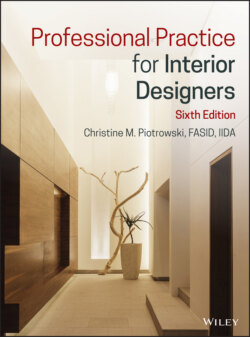Читать книгу Professional Practice for Interior Designers - Christine M. Piotrowski - Страница 151
Interview Basics
ОглавлениеAs an old advertisement once put it, “You only have one chance to make a first impression.” Now is that chance, and it can be absolutely critical to the outcome of your interview.
You have done your homework and are prepared for this important meeting. When you are approached, smile! Say hello, and introduce yourself. Be prepared to shake hands by holding any items you have brought in your left hand.
When you arrive at the conference room or office where the interview will be held, wait for some indication from the interviewer as to where to sit. If she does not make any indication as to where to sit, choose a chair that is either directly across from the interviewer or at a 90° angle. These two positions make it easier to show your portfolio and maintain eye contact.
Remember that the purpose of the interview is for the employer to get to know you personally, ask you questions, and try to evaluate whether you would be a good addition to the firm. The interviewer will be looking for information and personal conduct that shows you will be able to do the job and will fit in with the existing team. If the applicant is an experienced professional, the interviewer is also looking for clues that she is even willing to work for the firm.
As you are being interviewed, keep several things in mind:
Refrain from distracting mannerisms such as fussing with your hair or accessories, or playing with a paper clip or pen.
Pay attention to your own body language; don't slouch or otherwise allow your body language to communicate disinterest.
Listen carefully at all times. Do not fall into the trap of thinking about what you want to say while the other person is talking.
Ask for clarification if the interviewer says something you don't understand.
Think before you speak, and do not interrupt the interviewer.
Use eye contact; smile, and show interest.
The interview is a time for you to evaluate whether this particular firm is really the kind of firm for which you wish to work. Just because a firm has a good reputation does not mean that you will want to work for it. Create your own internal list of what you want to know about the company through the questions you will ask during the interview.
The employer has already formed some sort of impression of you from the information she has gleaned from social media and your initial interactions. Now that you are in the actual interview environment, it will be helpful to point out some interview tactics that the employer might use.
After the initial small talk that will not doubt start the interview, it is common for the interview to start with “Tell me about yourself.” You have prepared yourself for this type of question, so tell them! But don't simply repeat what is in your resume or otherwise has been posted about yourself.
Understand that there are different styles of interviews that might be used. The most common style is the situational interview where the employer might ask a lot of questions like, “What would you do if the client vetoed every single design idea you presented at the final presentation?” The interviewer is trying to see how you think on your feet. Briefly think about the question and then provide an answer.
In some cases, the employer will purposely ask you questions that will put you under even more stress than you are already experiencing. The idea, as far as the employer is concerned, is to find out how you might react under the worst conditions. Stay calm. It's not a personal attack though the tough sounding approach may seem to be. And do not become sarcastic or defensive. If the interview is conducted in a particularly stressful or abrasive manner, you might not want to work at that company anyway!
Some firms use team or multiple interviews. This means that: more than one person will question you during the interview; you will be passed from staff member to staff member during the interview period; or you may have to return for additional interviews with the same or other people. This happens frequently in larger design firms, where an ability to fit into the team and the existing company culture are important.
Understand that everyone probably has a preplanned part to play in the interview. One interviewer may be casual, another may be formal, and another may appear not to be interviewing you at all but observing your behavior. Be respectful of everyone, and be prepared for a long interview process.
Most interviews in interior design are not designed to induce stress. As best as you can relax and enjoy the opportunity to talk to the employer. Focus on your qualifications in terms of what you can do for the company. Graduating students need to indicate a willingness to learn. Be enthusiastic in your answers, and stress your positive characteristics.
